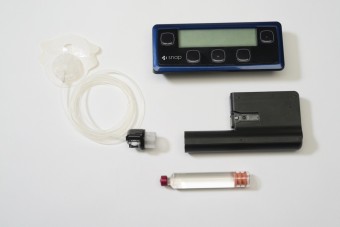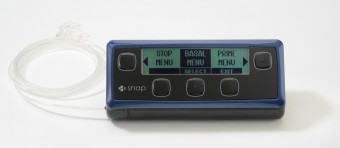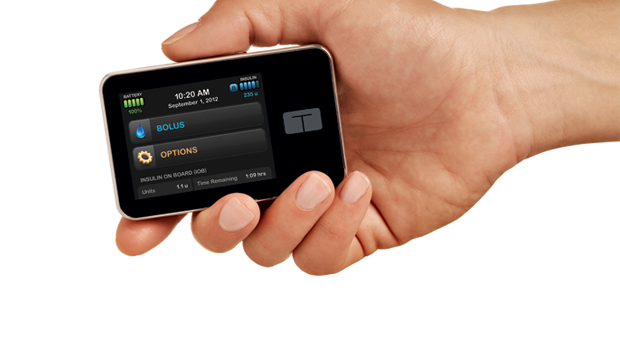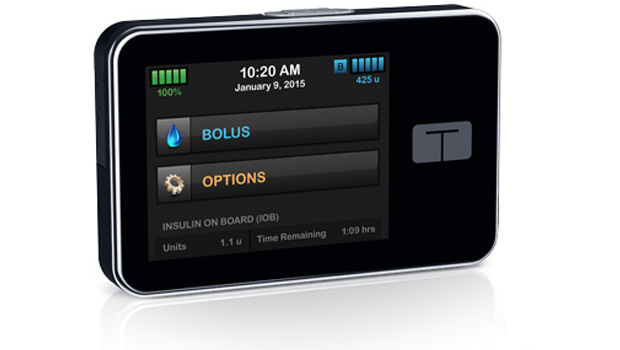Road-Testing Asante’s Snap Insulin Pump

Medical device development, and insulin pumps in particular, follows a well-trod path, worn smooth in the 40+ years since insulin was first combined with an infusion set. In the clinical trials stage, great care is taken to include people who have no previous pump experience, in order to observe how intuitive the command and control design is. By contrast, once the beta version of the product is ready, it’s time to bring in the pros – insulin pumpers who have years of experience and exposure to multiple devices. Refinements made as a result of their reactions usually determine the functions and features ultimately marketed to customers.
Asante asked a number of pump veterans to road test its new Snap insulin pump (www.snappump.com) for 4 weeks in March and April. Here’s a brief summary of reactions, pro and con, from 2 of them – Gary Scheiner and “Iron Andy” Holder. Scheiner, founder and CEO of Integrated Diabetes Services (www.integrateddiabetes.com) has been exposed to every model of insulin pump on the market (not to mention all the glucometers and CGMs) as a result of his profession. Holder, an Ironman triathlete diagnosed with Type 1 diabetes in 2006, has used a number of pumps, subjecting them all to the harshest possible use in the course of training and competing.
Of course, Scheiner and Holder each approached the 4-week trial from different perspectives. As a CDE and diabetes professional, Gary offered a more detailed clinical perspective of pros and cons. Andy, without Gary’s formal training, offers a more consumer-oriented perspective. Interestingly, however, each arrived at essentially the same set of conclusions. Below we summarize their comments – pro and con – in four important areas: convenience, insulin delivery options, warnings, and cost.
Convenience
Aside from the obvious benefit of not having to inject, which is true with all pumps, Gary identified two key convenience advantages: Snap’s pre-filled 300 unit insulin cartridge and the ”battery on board” that’s built into each pump body. Andy agreed, commenting after he returned to his old pump, “I felt like I was refilling my insulin every day. It only saves a couple of minutes, but over time the minutes add up.” Not surprisingly, Snap promotes its quick change-out in a series of light-hearted videos.
On the “con” side, both Gary and Andy commented that the pump was noisy when working, described by Gary as a “hum” and by Andy as a “quack quack” sound. Snap’s product team acted on this feedback, and excessive noise is no longer an issue..
A more important “hole,” noted by Scheiner, is that, so far, Snap has no software users can install on their computers to download results and map trends. Asante will offer two solutions to this, one for patients, and the other for their medical team, beginning as early as the 4th quarter of 2013. The patient solution lies in a partnership with mobile diabetes management platform Glooko (www.glooko.com) for analytics. Doctors and other diabetes professionals will be able to download data using Snap’s other partnership, with Diasend, a Web based platform for medical professionals. An upgraded version of Snap compatible with both Glooko and Diasend should be available as early as the 4th quarter of 2013, at a cost of $99. Setting up partnerships with well-designed and FDA-cleared data utilities like Glooko and Diasend, rather than inventing yet another proprietary software package to display and decipher data, makes so much sense that other pump makers might scratch their heads and wonder, “Why didn’t we think of that?”
Finally, Snap’s pre-filled insulin cartridge only delivers Lilly’s Humalog right now. Asante says that discussions with Novo Nordisk about a Novolog cartridge are well underway. Andy commented that he switched from Novolog to Humalog during the Snap trial and had no adverse effects, but, of course, you cannot generalize reactions from one person to other people with diabetes.
Insulin Delivery Options

Putting on his diabetes educator hat, Gary found several things to like about Snap’s infusion options. Quick entry to the bolus calculator, future bolus reminders, a temporary basal as high as the maximum basal setting, and the pump’s carb-adding feature all caught his eye.
On the downside, Gary felt that the version of Snap he tested did not have enough carb ratios, and he noted that the Smart Bolus feature could not be used if the user’s glucose reading was 70 or below. The Asante Team added more carb ratios in response to his feedback, and Ken El-Sherif, VP of Marketing for Asante, notes that “the Smart Bolus feature is disabled below 70, which we consider a safety feature. We decided it was best to encourage people with diabetes to treat the low before adding more insulin. Some very sophisticated users, like Gary, may see this as a disadvantage. For them, the now bolus feature can easily be used.”
Warnings
A pump is a machine that requires human maintenance, and at times we are too busy to notice a problem or a situation that’s about to be one. That’s why warnings are important, and here Gary feels that Snap is full of useful features. A low insulin warning on wake-up is built in, as are alerts for water or moisture damage, and a damage-from–drop warning. Alerts can be set separately for both weekdays and weekends, and there is an insulin-on-board feature available in 15-minute intervals, deducted as a result of correction or meal boluses.
Andy, who frequently exposes his pump to water or unusual impacts because of his training environments, really appreciated the water/moisture and drop alarm features.
Two potential issues stood out to Gary during his trial. One is the lack of a “vibrate” feature, which Asante says will be integrated into its next generation product, likely available later this year. The other problem Gary noticed was that Snap’s occlusion alarm was too sensitive in his test pump, often sounding alarms when there was really no problem. El-Sherif was quite thankful to get the feedback and says that the too-sensitive occlusion alarm problem has been addressed in current versions of Snap.
Cost

One benefit Gary and Andy both agree on enthusiastically as a benefit is the low initial cost of Snap. With a pricing structure similar to that of Insulet’s OmniPod, Snap is the lowest-cost pump on the market, and also carries a lifetime $99 upgrade feature. Scheiner points out that, with durable medical equipment insurance reimbursements under pressure, a typical pump from one of the major brands could require a co-pay of as much as $3000. That’s not pocket change. Over three-plus years, the total costs of ownership will level out between pumps that require a bigger up-front payment and Snap. But the initial cost of entry is one of Snap’s most valuable assets.
The bottom line: Gary and Andy each thought Snap was a feature-rich product that made blood glucose management less of a chore. Scheiner, in fact, cast the ultimate vote anyone with diabetes can give a manufacturer: as soon as his insurance paperwork is processed, he’ll be switching to Snap.
Thanks for reading this Insulin Nation article. Want more Type 1 news? Subscribe here.
Have Type 2 diabetes or know someone who does? Try Type 2 Nation, our sister publication.






